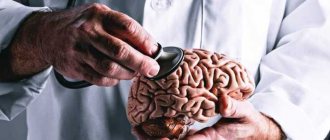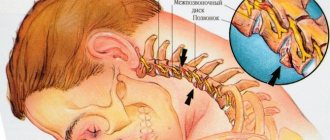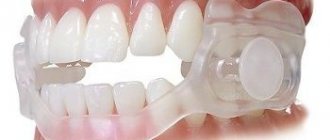Sometimes it seems that everything is very bad. And it can't get any worse. I don’t want anything from life, it’s impossible to pull myself together. And it is at this moment that you want some kind of kick from the outside. So that they come, shake us up, and tell us how to move on with our lives.
So here it is. Hello, we are Pics, we are your personal kick. We have collected the most powerful motivating films. They are based on real events. The heroes are ordinary people who suddenly find themselves in unusual situations, but at the same time extremely unpleasant for themselves. And they managed to cope with them.
Concept and code according to ICD-10
Residual encephalopathy is a type of brain pathology in which the death of a certain group of nerve cells without the possibility of their subsequent restoration.
This disease is not an independent disease.
The development of pathology occurs when the underlying disease is treated incorrectly or incompletely, which has a negative effect on the brain .
Residual encephalopathy can develop at a rapid pace and provoke serious deviations in the performance of vital body systems.
Features of the disease:
- symptoms of residual encephalopathy may appear several years after treatment of the underlying disease;
- According to ICD-10, the pathology is assigned the number G93.4 - “unspecified encephalopathy.”
Watch when you think the circumstances are stronger
Survive (1992) DIRECTOR: FRANK MARSHALL
A small group of schoolchildren survived a plane crash over the Andes. They found themselves high in the mountains, far from civilization. The search team has stopped its work, and now the guys face a brutal test of survival that will show what they are worth. Seventy-two harsh days, when the wing of an airplane serves as a roof, and the bodies of dead comrades serve as food. The most difficult thing in such conditions is to remain human.
Residual encephalopathy of perinatal origin
Residual encephalopathy of perinatal origin is a separate type of pathology that develops during gestation or during childbirth .
The diagnosis is made when the disease occurs from the 28th week of pregnancy until the end of the first week of life of the newborn child. The provoking factor is negative influences and brain damage.
The risk of developing residual encephalopathy of perinatal origin increases with the following factors:
- multiple pregnancy;
- premature or late birth;
- mother's age is over 40 or under 20 years;
- placental abruption during pregnancy;
- taking potent medications during pregnancy;
- other types of complications of a woman’s condition during pregnancy.
Causes
Residual encephalopathy develops against the background of death of nerve cells in the brain. This condition can be provoked by numerous external and internal factors affecting the child in the prenatal period or after birth.
Identifying the exact cause of the pathology is difficult in some cases. To determine the provoking factor, a special set of examinations of the small patient is carried out.
provoke the development of residual encephalopathy:
- Hereditary predisposition.
- Consequences of traumatic brain injuries (regardless of the child’s age).
- Atherosclerotic lesion of cerebral vessels.
- Increased levels of bilirubin and urea.
- Fetal hypoxia during intrauterine development.
- Negative effects of toxins on the fetus or the child’s body after birth.
- Inflammatory processes of the nervous tissue of the brain.
- Consequences of fetal infection.
- Cerebrovascular accident.
- Instability of blood pressure.
- Complications of vegetative-vascular dystonia.
- Complications of viral and infectious diseases.
Classification of pathology
Residual encephalopathy can be congenital or acquired. In the first case, the pathology develops during the period of intrauterine formation of the fetus, in the second it arises due to certain negative factors affecting the child’s body after his birth.
Based on severity, residual encephalopathy is divided into three categories. At the initial stage of pathology development, brain tissue is affected. With moderate severity, clinical symptoms become more pronounced. The severe form is accompanied by persistent neurological disorders .
Congenital residual encephalopathy is divided into the following types:
Symptoms and signs
The symptoms of residual encephalopathy have some features that distinguish it from other forms of this pathology.
Over a long period of time, the disease can develop in a latent form.
For example, if a child received a head injury, as a result of which the nerve cells of the brain began to die, then encephalopathy may appear several years after the incident. The intensity of the signs of the disease depends on the degree of progression of the pathological process.
Signs of the development of residual encephalopathy may include the following conditions:
- Sleep disturbance and moodiness.
- Inappropriate reaction to various stimuli.
- Impaired memory and intellectual abilities.
- Regular attacks of vomiting and nausea.
- Lack of sucking reflex in infancy.
- Muscle hypertonicity.
- Movement disorders.
- Bulging eyes.
- Emotional lability.
- Heartbeat disturbance.
- Weak or late cry at birth.
- General weakness of the body and apathy.
- Excessive fatigue.
Symptoms
Residual encephalopathy in an adult patient is accompanied by the following symptoms:
- Sudden memory loss. The patient becomes forgetful. He may have difficulty remembering even recent events.
- Decrease in intelligence. The patient's thinking process is disrupted due to the death of neurons and impaired cerebral circulation.
- Emotional lability. The patient's mood often changes, and there is increased irritability and tearfulness.
- Sleep disorders. Patients suffer from insomnia at night, and during the day they feel drowsiness and lethargy.
- Convulsive seizures. Seizures become more frequent as the disease progresses.
- Speech, vision and hearing disorders. The patient slurs his words. Vision and hearing deteriorate due to the death of nerve cells.
- Impaired coordination of movements. The patient's gait becomes unsteady, and he often loses his balance.
- Asthenia. The patient complains of constant fatigue and high fatigue.
- Headache. Migraine-like attacks occur. In this case, the pain syndrome is not relieved by analgesics.
These manifestations of pathology increase as the disease progresses. The more neurons die, the more severe the impairment of brain function.
What signs indicate a diagnosis of REP in a child? This disease can sometimes be difficult to identify in young children. After all, the baby cannot complain about feeling unwell. Parents should be alert to the following manifestations:
- tearfulness;
- increased reaction to external stimuli;
- frequent nausea and vomiting;
- weak sucking reflex;
- increased muscle tension;
- arrhythmia;
- exophthalmos (bulging eyes).
In older children, the disease is accompanied by the same symptoms as in adults. Residual encephalopathy has an extremely negative effect on the child’s intelligence. Children lag behind in mental and physical development, experience difficulties in assimilation and memorization of information, and it becomes difficult for them to study. Often, sick children experience sudden fainting.
Complications and consequences
Residual encephalopathy can have an extremely negative impact on all systems of the child’s body. The disease provokes disruption of the performance of certain parts of the brain, which cause the progression of irreversible pathological processes .
Children who suffered from this disease in childhood are lagging behind in physical, mental and speech development. Additionally, complex diseases develop that change the quality of life and shorten the life cycle.
Complications of residual encephalopathy can be the following pathologies:
- cerebral paralysis;
- progressive dementia;
- Parkinson's disease;
- vegetative-vascular dystonia;
- epilepsy;
- developmental delay.
Watch when you think you won't be able to do what you love
Soul Surfer (2011) DIRECTOR: SEAN MCNAMARA
The heroine of the film has been raving about surfing since childhood and does it all her free time. But at the age of 13, she is suddenly attacked by a shark - and the girl loses her arm. It would seem that there is no hope of continuing what you love. But the heroine finds the strength to get back on the board and trains to take part in the competition along with other athletes.
Diagnostics
Diagnosis of residual encephalopathy is a complex process that includes many laboratory and instrumental techniques for examining a small patient.
In the early stages of the development of pathology, its symptoms can develop in a latent form.
The only way to detect the disease is a comprehensive examination of the child’s brain.
The following procedures are used for diagnosis:
- electroencephalography;
- MRI of the brain;
- CT scan of the brain and internal organs;
- general blood and urine analysis;
- nuclear magnetic resonance;
- Doppler ultrasound;
- biochemical analysis of blood and urine;
- cerebrospinal fluid puncture.
Treatment methods and drugs
Several treatment methods are used in the treatment of residual encephalopathy. To normalize brain function, the child is prescribed special medications.
At the second stage of therapy, procedures are used that consolidate the results of medications (physiotherapy, physical therapy, therapeutic massage, etc.). If there are complications, a small patient may need surgery.
Treatment of residual encephalopathy uses the following drugs :
- vitamin complexes appropriate for the child’s age;
- anticonvulsants;
- medications to improve cerebral circulation;
- non-steroidal anti-inflammatory drugs;
- hormonal drugs;
- means to accelerate the regeneration of brain tissue.
Prognosis and possibility of military service with this diagnosis
Favorable prognosis for residual encephalopathy is possible only with timely diagnosis of the pathology and its full treatment. An important role is played by the general health of the child and the reasons that provoked the disease.
Residual encephalopathy is not included in the list of diseases exempt from military service , but a ban on conscription may be due to complications of the disease.
For example, if a diagnosis of “dyscirculatory encephalopathy” is established, then exclusion from the ranks of conscripts automatically occurs.
Watch when you think you can't be a leader
The King's Speech (2010) DIRECTOR: TOM HOOPER
The story of Great Britain's King George VI, father of the current Queen Elizabeth II. He led the empire at a difficult moment when the country entered World War II. Georg was the youngest son in the family and suffered from a severe stutter. No one could have imagined that the insecure stutterer would become one of the most prominent kings in history.
Prevention
Preventive measures to prevent residual encephalopathy include basic rules of child care and careful attention to the state of his health , starting from the stage of intrauterine development.
If a woman is diagnosed with chronic diseases, then before conception it is necessary to undergo a course of examination, and also try to take measures to prevent exacerbations of pathologies during pregnancy.
Recommendations for the prevention of residual encephalopathy in children:
- Regular examinations of women during pregnancy (scheduled and unscheduled if alarming symptoms occur).
- Timely and complete treatment of diseases of any etiology in a child (especially viral and infectious diseases).
- Prevention of traumatic brain injuries in a child (including birth injuries).
- Prevention of stressful situations and any negative impact on the child’s psyche.
- From an early age, a child should eat right, spend enough time in the fresh air, and play sports.
- Maintaining sleep and wakefulness (excluding the child’s regular lack of sleep, excessive physical activity, etc.).
- The baby’s immune system must be strengthened from an early age (if necessary, the supply of vitamins in the body must be replenished with special preparations).
Residual encephalopathy is one of the dangerous and intractable diseases. Favorable prognosis is possible only with early diagnosis of the pathology and timely treatment. Otherwise, it will be impossible to eliminate developing pathological processes.
The video provides an overview of a disease such as residual encephalopathy:
“We kindly ask you not to self-medicate. Make an appointment with a doctor!
Residual encephalopathy is a rather complex disease. The word "residual" means residual.
That is, the disease was not completely cured and left its roots. This diagnosis is made if the patient had some kind of brain damage , and the doctors were unable to treat him. The disease manifests itself within several months or several years. It is unknown how these consequences of “undertreatment” will manifest themselves.
Each person's brain reacts individually to illness. The age of the patient also plays an important role. The disease can manifest itself in any degree of severity and have different consequences.
Thus, it can be clarified that residual encephalopathy is partly a “collective” diagnosis , consisting of various manifestations.
Variety of causes of the disease
When all the negative factors taken together begin to affect the brain cells, the brain cannot cope with the load, and some cells die under such pressure.
Although the brain cells will recover after a certain period of time, after a certain period, this ability will weaken. This is how a person develops encephalopathy.
Let's analyze what reasons can influence the development of residual encephalopathy:
- These are traumatic shocks that happen to the human brain quite often: various injuries, concussions and bruises.
- The disease can be caused by a complicated pregnancy process, as well as the birth process.
- Encephalopathy can be caused by exposure to toxins. Therefore, it is not recommended to use salts of heavy metals, large portions of alcoholic beverages, poisonous elements and toxic medications.
- All types of drugs and psychotropic drugs can also cause residual encephalopathy.
- If, in diseases of the liver and kidneys, urea is released in large quantities, then this can also be a signal for the development of encephalopathy.
- Strokes also increase your chance of getting sick. We also include sclerotic lesions of the brain, which negatively affect blood circulation.
- Also, diabetes can cause some changes in the body, leading to abnormalities in brain function.
- Inflammation of the nervous tissue of the brain. The long-term influence of ionizing radiation on the body is one of the most important reasons for the development of residual encephalopathy.
Watch when life has reached a dead end
The Pursuit of Happyness (2006) DIRECTOR: GABRIELLE MUCCHINO
This is a biography of millionaire Chris Garner. The action takes place in the eighties. Then young Chris was left on the street with his five-year-old son. He had neither a home nor a job, but had a great desire to escape poverty. Despite the catastrophic situation and against all logic, he gets a free six-month internship at a brokerage company.
Symptoms and signs inherent in the disease
Symptoms of residual encephalopathy will be primarily related to the sites of damage to the body. So most often you can find the following symptoms:
- the patient’s memory may be impaired for both a short and longer period;
- a person’s mood can change with considerable speed: now he is smiling, and the next minute he is already crying;
- the patient suffers from insomnia at night, and during the day he is lethargic and constantly sleepy;
- sudden attacks of headaches that tend to increase pain. Medicines usually do not help;
- general weakening of the body, constant fatigue;
- attacks of paralysis or manifestations of Parkinson's disease;
- the patient’s intelligence is significantly impaired as blood circulation in the brain decreases;
- convulsions;
- decreased vision and hearing;
- slurred speech, coordination problems, migraines that can lead to coma.
Typically, residual encephalopathy is a disease that is gaining momentum.
Every day, minor and harmless symptoms lead to general disorders of the brain. Sometimes an immediate manifestation of the disease is possible when it develops very quickly.
Watch when it seems like there is no way out
127 Hours (2010) DIRECTOR: DANNY BOYLE
A young guy went for a walk through the gorges without telling anyone where he was going. This walk turns into tragedy. A falling cobblestone pinches the hero's hand, and he finds himself trapped. The guy will have to fight for his life for several days. A story about how a person who finds himself on the brink can manifest himself in the most surprising way.
Diagnostic techniques
Making a diagnosis of residual encephalopathy can be very difficult if the first symptoms appear quite a long time after the brain has been exposed to factors that could cause damage.
Sometimes residual encephalopathy of the brain can acquire signs of other diseases, so the diagnosis may not be made accurately.
Diagnostic methods include the following:
- The main role in diagnosing the disease is the testimony of the patient himself. He must clearly explain the reasons that could cause the collapse of brain cells.
- An electroencephalography procedure is mandatory for all patients. It is carried out with the aim of accurately analyzing the functioning of the entire brain and its cells in particular. Allows you to identify even pathological diseases.
- Computed tomography is necessary to study the patient's internal organs using X-rays.
- Nuclear magnetic resonance is performed to look at the biochemical processes that occur inside the tissues and cells of the body.
- Magnetic resonance imaging is also necessary to study processes occurring at the cellular level in body tissues.
- The main role in diagnosis lies with urine and blood tests, which will show the full picture of the disease.
Meningioma of the brain is a curable, most often benign brain tumor. Timely treatment increases the patient's chances of recovery.
Watch when you think that the immediate goal is more important than the future
Coach Carter (2005) DIRECTOR: THOMAS CARTER
The coach of a successful basketball team introduced a strange rule. He stopped putting on the field those players who had problems at school. And the kids studied extremely poorly. This decision caused a big scandal both in the team and in the championship as a whole, because the team had to miss several matches. The players had to take up their studies, but will they be able to win the championship at the same pace?
Treatment of residual encephalopathy
In order to cure such a serious illness as encephalopathy, it is necessary to pursue the main goal - to improve or at least normalize blood flow in the brain . For this purpose, special drugs are taken.
Non-steroidal and hormonal drugs have a good effect. A weakened body also needs a full complex of vitamins and minerals. Also, if indicated, anticonvulsants are prescribed.
In order to achieve the greatest result in the treatment of residual encephalopathy, especially in a child, the doctor may prescribe several methods:
- The first is a manual therapy session . It is a kind of massage that promotes blood flow to the brain, thereby increasing its functioning.
- Reflexology . This includes acupuncture and acupuncture. The purpose of this method is to influence the human body from the outside, using special points that can awaken its reflexes, which in turn will help the body “shake up” and turn on its protective functions.
- Special gymnastics and procedures can put a significant load on the entire body, which will bear fruit: a person’s muscle tone increases, blood circulation and blood flow to problem areas improve, provided that all the recommendations of a specialist doctor have been followed.
Watch when you think that nothing can help these people
Triumph: The Ron Clark Story (2006) DIRECTOR: RANDA HAINES
The main character is a teacher who believes that a good teacher can teach any child. He moved to New York from a small provincial town and took the most difficult class in a Harlem school to confirm his theory in practice. A couple of dozen uncontrollable teenagers encountered a person who truly believes in them.
Complications and consequences
residual encephalopathy in a child
Complications and consequences associated with residual encephalopathy are severe and frequent. Their occurrence directly depends on the qualifications of the doctor and on how quickly the patient sought help.
develop as consequences
- hydrocephalic syndrome (when the fluid that forms under the cerebral cortex becomes too much, and the brain simply cannot remove it normally);
- vegetative-vascular dystonia (disorders affecting blood vessels);
- residual brain dysfunction (the disease is associated primarily with mental disorders in its cortex);
- cerebral palsy (a complex of chronic diseases associated with abnormalities in the brain);
- epilepsy (convulsive seizures, which are accompanied by a faint state of the patient).
Watch when it seems like there are no kind people in the world
The Blind Side (2009) DIRECTOR: JOHN LEE HANCOCK
A wealthy family took custody of a homeless and illiterate black boy, deciding to educate him. At first glance, it seems that the guy is hopeless. He is very kind, but he has no ability to learn. However, the boy has one distinctive feature that allows him to become a sports star and go to university.
Prevention of residual encephalopathy
In order to protect yourself and your body from this and other diseases associated with disorders in the brain, you should isolate yourself from the causes that can cause the disease.
First of all, you need to see a doctor as often if you begin to suffer from even the slightest manifestations of the disease. If a diagnosis is made, then treatment should be carried out as accurately and effectively as possible until all symptoms completely disappear.
useful :
- walks in the fresh air (improves oxygen saturation of blood and brain cells);
- gymnastics with an emphasis on the collar area (to improve blood supply to the brain);
- a diet rich in vitamins and minerals, especially when performing heavy mental activity.
Forecast
If the diagnosis of REP was made in a timely manner and the patient completed the full course of therapy, then the disease can be cured. Lost neurons can no longer be restored. But if the process of brain cell death has just begun, then therapy will help maintain the normal function of the central nervous system. Therefore, treatment is effective only at the initial stage of the pathology.
In advanced cases, it is no longer possible to restore lost brain functions. Even after treatment, the patient retains signs of memory impairment, thinking disorders and emotional lability. In children, this can lead to severe mental impairment.









